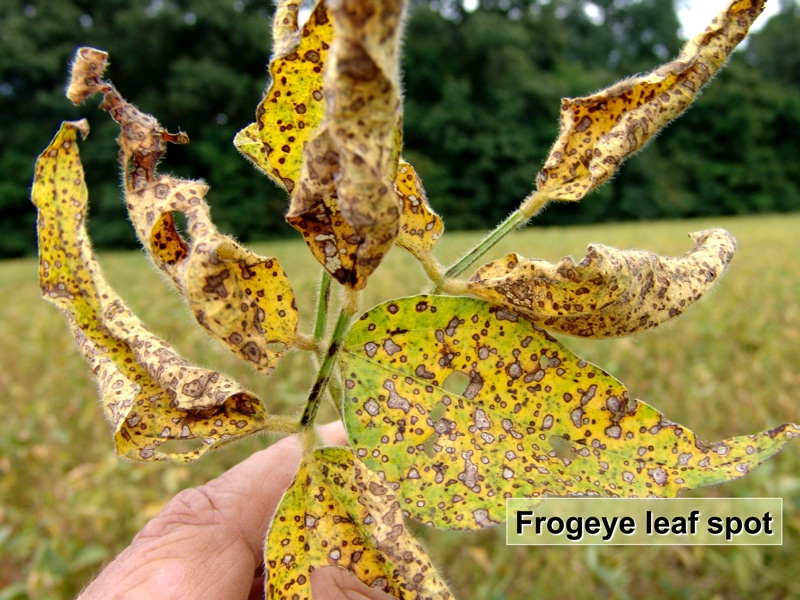
Frogeye leaf spot from a single west Tennessee soybean field has been confirmed as resistant to strobilurin fungicides.In tests, spores from isolates of Cercospora sojina germinated in the presence of high concentrations of azoxystrobin, pyraclostrobin, and trifloxystrobin, which are the strobilurin active ingredients found in Quadris, Headline, and Stratego.The best option for managing resistance to fungicides is to use a resistant or highly tolerant soybean variety. Rotation and tank-mixing a triazole with a strobilurin are also recommended.

Frogeye leaf spot from a west Tennessee soybean field has been confirmed as resistant to strobilurin fungicides, according to University of Tennessee Extension plant pathologist Melvin Newman.
Newman said a farmer in Lauderdale County called him this season after a second application of a strobilurin fungicide did not control frogeye leaf spot.
Newman said the farmer made both fungicide applications on the field at the proper time and rate. The soybean variety in the field was susceptible to the disease.
Newman sent plant samples from the field to Carl Bradley, University of Illinois Extension plant pathologist, “who was already running tests on frogeye leaf spot resistance. That’s how we got it diagnosed so quickly. The results showed that the fungus was resistant to three different strobilurins.”
According to Bradley, in petri dish tests conducted at the University of Illinois, spores from isolates of Cercospora sojina germinated in the presence of high concentrations of azoxystrobin, pyraclostrobin, and trifloxystrobin, which are the strobilurin active ingredients found in Quadris, Headline, and Stratego.
“This proved we were dealing with isolates that have reduced sensitivity to strobilurin fungicides,” Bradley said. “Currently, Tennessee is the only state in which we have documented isolates like these, but we are continuing to perform tests on isolates collected from fields in Illinois and other states.”
Bradley said that strobilurin fungicides have been deemed high risk for fungal pathogens developing resistance to them by the Fungicide Resistance Action Committee, an international committee that evaluates fungicides’ likelihood of developing resistance.
Fungi developing resistance to strobilurin fungicides “has already occurred in potatoes and other crop and disease systems where multiple fungicide applications occur during the growing season,” Bradley said.
Newman says the resistant strain of fungi “is not a monster that’s going to control the world. But it is a wakeup call for soybean producers.”
Newman says to manage fungicide resistance, “the best option is to choose a resistant or highly tolerant soybean variety. “There are a number of tolerant varieties in just about any maturity group. Varieties can become susceptible though over time, due to the fungus changing. We’ve seen that happen.”
Oftentimes, susceptible varieties are preferred by growers over resistant varieties “if they yield well, and the disease can be controlled with fungicides,” Newman said. “But that didn’t work for this field.”
When spraying a fungicide on soybeans, Newman suggests choosing a strobilurin “either tank-mixed or pre-mixed with a triazole. That would insure that any leaf spot that escaped the strobilurin would be controlled by the triazole. Another option is to get out of soybeans for a couple of years if you’ve noticed resistance. One year out of soybeans would be good, two years would be better.”
Newman advises producers who haven’t seen resistance to also “get a triazole in the mix. Now that we know it can happen, we need to take steps to slow it down in areas that haven’t been affected yet.”
Newman expects resistance to reoccur in the Lauderdale County field next year, “if the producer plants a susceptible soybean variety and we have enough moisture to have disease. But if he rotates to something like cotton for a couple of years, there’s a chance the fungus could be greatly reduced.”
Newman said other diseases such as septoria brown spot and anthracnose “are not implicated.”
Strobilurin fungicides belong to the chemistry class known as the quinone outside inhibitors, which are the most widely used group of foliar fungicides applied to field crops to manage plant diseases.
These fungicides can be sold as one-active ingredient products such as Headline or Quadris or in products that combine them with a fungicide in a different chemistry class known as the demethylation inhibitors, sometimes referred to as triazoles, Bradley said. Products that include a strobilurin-triazole combination of active ingredients include Quilt and Stratego.
Bradley says the most effective manner to slow the spread of resistant isolates is to only use a fungicide when needed. “Every time you apply a fungicide, you increase the selection pressure and the opportunity to select out individuals in the pathogen population that have resistance or reduced sensitivity to the fungicide.
“There’s a lot of marketing to use fungicides for yield increases, but little talk about where those increases come from. They come from protection of yield from diseases. In some cases they pay off because conditions have been favorable for diseases. But in years where conditions aren’t favorable for disease, we generally don’t see a big yield increase.”
Bradley’s crew is expanding its work in monitoring fungicide resistance in pathogens of corn. They are currently developing strobilurin sensitivity baselines for the gray leaf spot and northern corn leaf blight pathogens.
In 2008, Bradley’s laboratory began a project funded by the Illinois Soybean Association to develop a fungicide resistance monitoring program. The University of Illinois research will continue into the 2011 season.
For more information on frogeye leaf spot, read the alert in The Bulletin, an online publication written by University of Illinois Extension specialists in crop science.
About the Author(s)
You May Also Like





